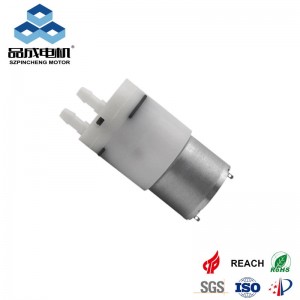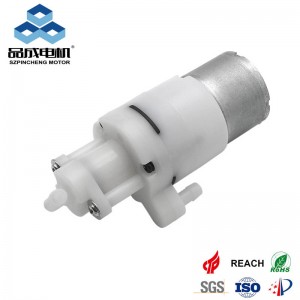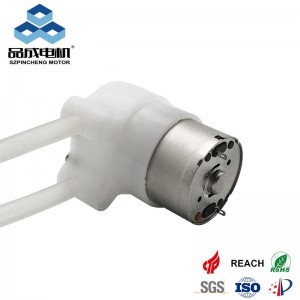The growing demand for micro pumps in chemical processing, pharmaceuticals, and semiconductor manufacturing has intensified the need for materials capable of withstanding aggressive solvents. This article explores the critical considerations in material selection, testing protocols, and emerging standards for solvent-resistant micro pump components, supported by advancements in polymer science and industrial case studies.
1. Key Criteria for Solvent-Resistant Material Selection
Chemical Compatibility:
Materials must resist degradation from solvents like acetone, toluene, and chlorinated compounds. For instance, PTFE (polytetrafluoroethylene) and PEEK (polyether ether ketone) are widely adopted due to their inertness to hydrocarbons and acids. Yamada Corporation’s NDP-series pumps, utilizing PTFE diaphragms, demonstrate zero swelling after 1,000 hours of exposure to semiconductor-grade solvents.
Mechanical Stability:
High-pressure applications (e.g., HPLC systems) require materials that retain tensile strength under stress. Stainless steel 316L and Hastelloy C-276 alloys are preferred for their dual resistance to corrosion and mechanical wear, sustaining pressures up to 50 bar in pharmaceutical solvent transfer.
Manufacturing Feasibility:
Materials must balance performance with manufacturability. For example, fluoropolymer composites enable precision molding of micro pump valves while maintaining chemical resistance—a technique refined by FLUX-GERÄTE GmbH for VOC-free magnetic drive pumps.
Cost-Effectiveness:
Bio-based alternatives like PVDF (polyvinylidene fluoride) offer 80% of PTFE’s chemical resistance at 40% lower cost, making them viable for disposable medical micro pumps.
2. Leading Material Candidates and Performance Benchmarks
A. Polymers and Composites
-
PTFE:
- Advantages: Exceptional chemical inertness, low friction, and thermal stability (up to 260°C).
- Applications: Diaphragms in solvent recovery pumps for semiconductor fabs.
- Limitations: Poor wear resistance; often combined with carbon fiber for durability.
-
PEEK:
- Advantages: High strength-to-weight ratio, resistant to steam and organic solvents.
- Case Study: Used in Graco’s UniRacer pumps for automotive coatings, reducing downtime by 30%.
B. Metals and Alloys
-
Stainless Steel 316L:
- Advantages: Cost-effective for mildly corrosive environments; ideal for ethanol and methanol handling.
- Testing: Survived 5,000 cycles in 20% HCl solutions without pitting.
-
Hastelloy C-22:
- Advantages: Resists oxidizing acids and chlorides; critical for API manufacturing pumps.
- Standardization: ASTM B575 mandates its use in pharmaceutical solvent transfer systems.
C. Ceramic Hybrids
- Alumina-Zirconia Composites:
- Advantages: Zero permeation, hardness comparable to diamonds.
- Applications: Ultra-pure solvent handling in EUV lithography pumps.
3. Testing Protocols for Solvent Resistance
Immersion Testing:
- Samples are submerged in solvents at elevated temperatures (e.g., 60°C) for 30–90 days. Weight change and surface degradation are measured per ISO 175 guidelines.
Pressure Cycling:
- Mimics real-world conditions by alternating between vacuum and high-pressure states. FLUX-GERÄTE’s magnetic drive pumps endure 10,000 cycles at 10 bar with <0.1% leakage.
Real-World Simulation:
- Micro pumps are tested in multi-solvent environments (e.g., petrochemical refineries). North Ridge Pumps’ IoT-enabled AODD systems monitor material fatigue under mixed xylene/acetone flows.
4. Challenges in Standardization
Divergent Industry Requirements:
- Semiconductor labs prioritize purity (ISO Class 1), while pharmaceuticals focus on FDA compliance. This fragmentation complicates universal standards.
Regulatory Gaps:
- Existing frameworks like EU REACH and U.S. EPA Chemical Safety Rules lack micro pump-specific guidelines for solvent compatibility.
Collaborative Initiatives:
- The International Micro Pump Consortium (IMPC) is drafting a tiered material classification system (2026 target), aligning with ISO 10993 for biocompatibility and ASTM D543 for chemical resistance.
5. Future Directions and Innovations
Smart Material Integration:
- Shape-memory alloys and self-healing polymers could enable real-time adaptation to solvent changes. Lab trials show SMA-coated pumps adjusting valve clearances when exposed to pH shifts.
3D-Printed Customization:
- Additive manufacturing allows topology-optimized pump casings in PEEK-CF composites, reducing solvent permeation by 60% compared to molded parts.
Biodegradable Solutions:
- PLA-based micro pumps are emerging for eco-friendly solvent dispensing, though longevity in aggressive environments remains a hurdle.
Conclusion
The selection and standardization of solvent-resistant materials for micro pumps demand a multidisciplinary approach, blending material science, regulatory compliance, and industry-specific needs. As technologies like AI-driven predictive maintenance and hybrid ceramics advance, harmonized global standards will accelerate innovation while ensuring safety and efficiency. Stakeholders must prioritize collaborative R&D to address solvent compatibility challenges in an increasingly miniaturized industrial landscape.
you like also all
Read More News
Post time: May-24-2025




